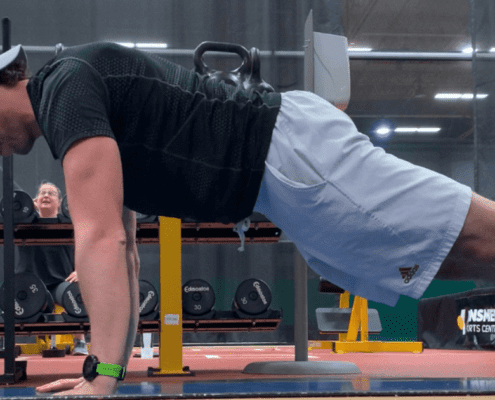Things To Consider When Returning To The Gym After A Break
Last updated September 8, 2022 by Michael Fouts
Read time: 5 min
Let me know if this sounds familiar. You take a break from working out, be it a vacation, a mental break, or some other reason. The day after your first workout you’re incredibly sore, more so the second day. Especially if you did leg day, which makes going down stairs or sitting on a toilet 8-9/10 pain.
What If I told you this level of pain can be avoided and is not a necessary requirement to getting back into a workout routine?
Yes, it’s true. Read on to understand how.
Modify Your Volume & Intensity
This is the most important thing to do. Let’s first clarify what that these variables mean.
- Volume is number of reps and sets you do for certain muscle group
- Intensity is the level of effort you put in while doing your reps, this is often referred to RPE (rate of perceived exertion), %1RM (percentage of 1 rep max) or RIR (reps in reverse). I personally like RPE as it tends to be most practical for the clients I work with; %1RM tends to work better with strength specific and powerlifting athletes, RIR tends to be popular in the dedicated bodybuilding community.
It may be both tempting and satisfying to return to the gym and lift similar weights you were doing before in the gym. This isn’t exactly a great idea, for a few reasons.
Th first reason is injury prevention. The larger the break, the great the chance of injury. There’s a lot of moving parts when you lift weights. Aside from muscles, you also have tendons, ligaments, and collagen in joints. Jumping the gun and lifting similar weights could overload some of these structures and an injury could happen.
The second reason is muscle soreness. If you don’t gradually return to lifting weights you will be sore, that is for certain; this can be seen with as little as 2 weeks off from weight training. Muscle soreness can be ok, but too much can be a bad thing. If you’re too sore you won’t be able to train as often – sometimes having to take 3+ days off – lift as heavy, and do certain movements without compensating.
Solution: in the first few weeks (2-4 weeks) work to build up your Intensity. Slowly increase the amount of weight you are using, mix up your rep ranges and “leave some reps in the tank” – If you’re doing 12 reps, which is a good start, you should be able to do 16-18 but stop at 12. Also, slowly increase the volume per muscle group (# of sets per muscle group). In other words, don’t do chest or arms day right when you get back to the gym. Mix in 2-3 Full Body days, then some Upper / Lower Body splits, then look to separate further if your training schedule permits 3+ days per week of weight training.
Here’s a 4-week example of how we would program for a client getting back into a fitness routine after for being off for 2 weeks or more. Something to keep in mind: this will be different for each person and will largely depend on their current level of fitness and conditioning. Some will be able to tolerate more loading, others less.
Some terms used below:
- Compound = multi-joint, eg. Squat, bench press, deadlift, etc.
- Isolation = single joint exercises, eg. Bicep curl, tricep extension, etc.
*Volume listed below pertains to maximum per one muscle group, per workout
Week 1
-Compound lifts: Intensity = RPE of 5-6/10; Volume = 3 sets
-Isolation exercises: Intensity = RPE of 6-7/10; Volume = 3 sets
Week 2
-Compound lifts: Intensity = RPE of 6-7/10; Volume = 3-5 sets
-Isolation exercises: Intensity = RPE of 7-8/10; Volume = 3-5 sets
Week 3
-Compound lifts: Intensity = RPE of 7-8/10; Volume = 3-7 sets
-Isolation exercises: Intensity = RPE of 7-9/10; Volume = 3-7 sets
Week 4
-Compound lifts: Intensity = RPE of 7-10/10; Volume = 3-9 sets
-Isolation exercises: Intensity = RPE of 7-10/10; Volume = 3-9 sets
Some other things to consider:
1. Incorporate The Core
Chances are your core may have been neglected during your break away from the gym. For the record, the core refers to any muscles that help stabilize your pelvis and is not just your ab muscles. When it comes to weight training the core is instrumental in almost all lifts – whether you train it directly or not.
Designate at least two core exercises for each workout to help strengthen the core; this will also help re-strengthen you lower back, which could alleviate any lower back pain you may have been experiencing due to lack of weight training.
Try these core exercises, 2-3 sets each for 10-12 reps:
2. Don’t Beat Yourself Up
Whether you took a break from the gym intentionally, or unintentionally, accept that this is ok. Life events unfold at unexpected times with unpredictable outcomes, whether it be a job transition, a new baby in the family, or a worldwide pandemic.
Everyone copes differently. The most important thing is you are choosing to return to training, and wanting to re-integrate healthy habits, and reap the long and short term benefits of regular exercise.
Don’t dwell on the past and instead be proactive about the future.
Got questions? Send us a message and we’d be happy to help. Looking to work with a trainer, who can help you return to weight training safely and consistently? We’d be happy to help, fill out this form and we’ll be in touch.






